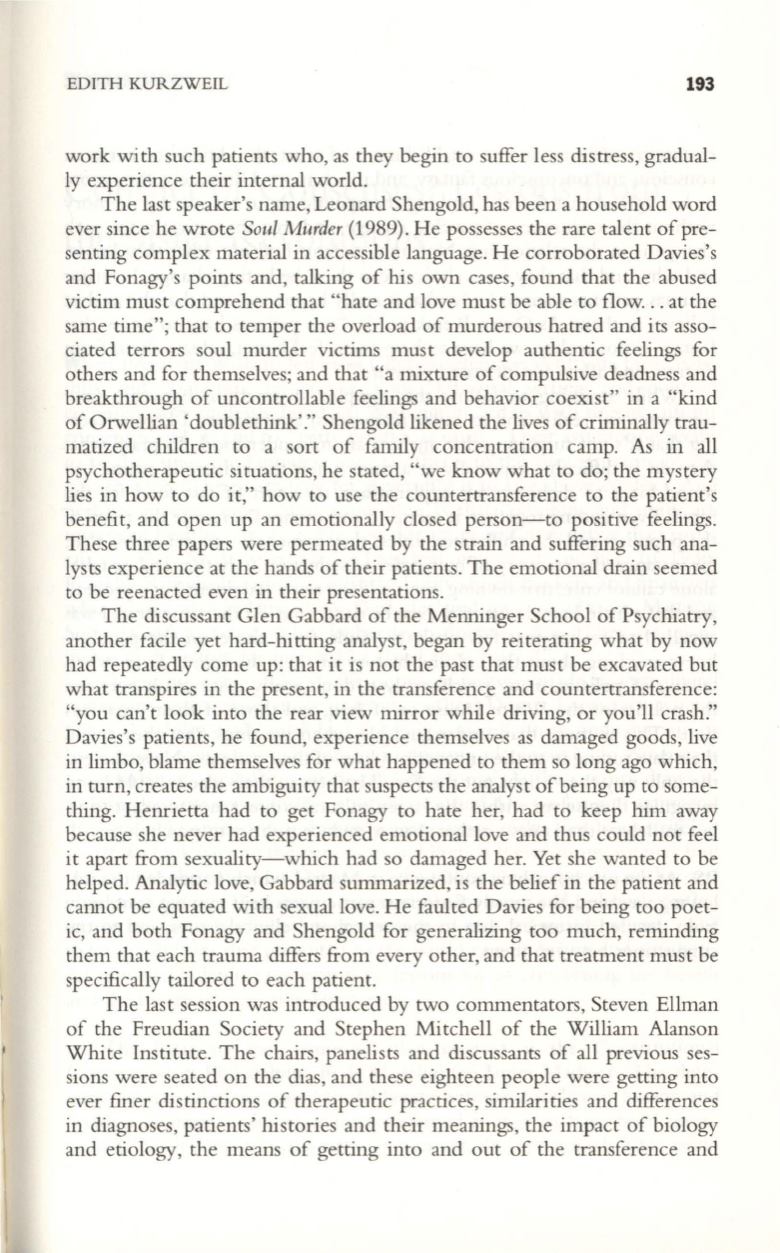
EDITH KURZWEIL
193
work with such patients who, as they begin to suffer less distress, gradual–
ly experience their internal world.
The last speaker's name, Leonard Shengold, has been a household word
ever since he wrote
Soul Murder
(1989). He possesses the rare talent of pre–
senting complex material in accessible language. He corroborated Davies's
and Fonagy's points and, talking of his own cases, found that the abused
victim must comprehend that "hate and love must be able to flow... at the
same time"; that to temper the overload of murderous hatred and its asso–
ciated terrors soul murder victims must develop authentic feelings for
others and for themselves; and that "a mixture of compulsive deadness and
breakthrough of uncontrollable feelings and behavior coexist" in a "kind
of Orwellian 'doublethink'." Shengold likened the lives of criminally trau–
matized children to a sort of family concentration camp. As in all
psychotherapeutic situations, he stated, "we know what to do; the mystery
lies in how to do it," how to use the countertransference to the patient's
benefit, and open up an emotionally closed person-to positive feelings.
These three papers were permeated by the strain and suffering such ana–
lysts experience at the hands of their patients. The emotional drain seemed
to be reenacted even in their presentations.
The discussant Glen Gabbard of the Menninger School of Psychiatry,
another facile yet hard-hitting analyst, began by reiterating what by now
had repeatedly come up: that it is not the past that must be excavated but
what transpires in the present, in the transference and countertransference:
"you can't look into the rear view mirror while driving, or you'll crash."
Davies's patients, he found, experience themselves as damaged goods, live
in limbo, blame themselves for what happened to them so long ago which,
in turn, creates the ambiguity that suspects the analyst of being up to some–
thing. Henrietta had to get Fonagy to hate her, had to keep him away
because she never had experienced emotional love and thus could not feel
it apart from sexuality-which had so damaged her. Yet she wanted to be
helped. Analytic love, Gabbard summarized, is the belief in the patient and
cannot be equated with sexual love. He faulted Davies for being too poet–
ic, and both Fonagy and Shengold for generalizing too much, reminding
them that each trauma differs from every other, and that treatment must be
specifically tailored to each patient.
The last session was introduced by two commentators, Steven Ellman
of the Freudian Society and Stephen Mitchell of the William Alanson
White Institute. The chairs, panelists and discussants of all previous ses–
sions were seated on the dias, and these eighteen people were getting into
ever finer distinctions of therapeutic practices, similarities and differences
in diagnoses, patients' histories and their meanings, the impact of biology
and etiology, the means of getting into and out of the transference and


